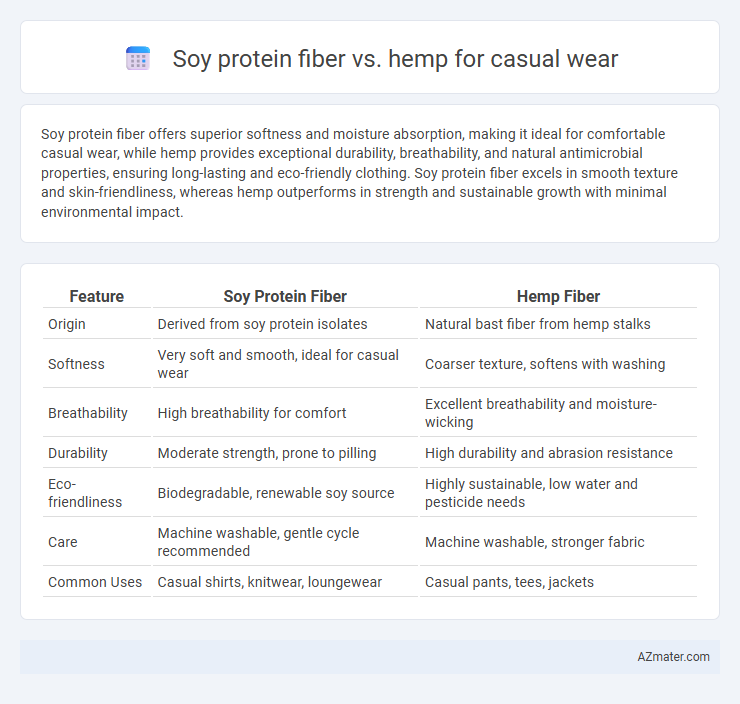Soy protein fiber offers superior softness and moisture absorption, making it ideal for comfortable casual wear, while hemp provides exceptional durability, breathability, and natural antimicrobial properties, ensuring long-lasting and eco-friendly clothing. Soy protein fiber excels in smooth texture and skin-friendliness, whereas hemp outperforms in strength and sustainable growth with minimal environmental impact.
Table of Comparison
| Feature | Soy Protein Fiber | Hemp Fiber |
|---|---|---|
| Origin | Derived from soy protein isolates | Natural bast fiber from hemp stalks |
| Softness | Very soft and smooth, ideal for casual wear | Coarser texture, softens with washing |
| Breathability | High breathability for comfort | Excellent breathability and moisture-wicking |
| Durability | Moderate strength, prone to pilling | High durability and abrasion resistance |
| Eco-friendliness | Biodegradable, renewable soy source | Highly sustainable, low water and pesticide needs |
| Care | Machine washable, gentle cycle recommended | Machine washable, stronger fabric |
| Common Uses | Casual shirts, knitwear, loungewear | Casual pants, tees, jackets |
Introduction to Soy Protein Fiber and Hemp
Soy protein fiber, derived from soybeans, offers softness, breathability, and excellent moisture-wicking properties, making it ideal for casual wear. Hemp fiber, known for its durability, natural antifungal qualities, and environmental sustainability, provides a strong yet comfortable fabric option. Both fibers present eco-friendly alternatives with unique textures and performance benefits for everyday clothing.
Sustainability: Comparing Environmental Impacts
Soy protein fiber and hemp both offer sustainable alternatives in casual wear, with hemp generally requiring less water and pesticides during cultivation, leading to a lower environmental footprint. Soy protein fiber, derived from soybean processing byproducts, promotes waste reduction but involves chemical treatments that may impact biodegradability. Hemp's rapid growth and ability to regenerate soil nutrients make it a more eco-friendly choice for sustainable fashion focused on minimizing agricultural impact.
Comfort and Feel: Which is Softer?
Soy protein fiber offers an exceptionally smooth and silky texture that enhances comfort for casual wear, often described as feeling like soft cashmere. Hemp fabric, while durable and breathable, tends to have a coarser texture initially but softens with each wash, providing a rugged yet comfortable feel. For those prioritizing immediate softness and gentle touch against the skin, soy protein fiber is generally considered softer than hemp.
Breathability and Moisture Management
Soy protein fiber offers excellent breathability due to its natural porous structure, allowing air circulation that keeps the skin cool and dry during casual wear. Hemp fabric is highly effective at moisture management, rapidly wicking away sweat and drying quickly to prevent discomfort and odor buildup. Both materials contribute to comfortable casual wear, with soy protein fiber excelling in softness and ventilation, while hemp ensures superior moisture absorption and durability.
Durability and Longevity in Casual Wear
Soy protein fiber offers moderate durability with a soft texture that resists pilling, making it suitable for casual wear requiring comfort and light resilience. Hemp fibers excel in longevity due to their natural strength and abrasion resistance, providing exceptional durability and maintaining shape over time even with frequent use. Casual wear made from hemp tends to outlast soy protein fiber garments, especially in active or outdoor settings where fabric endurance is critical.
Style and Versatility in Fashion
Soy protein fiber offers a smooth, lightweight texture that drapes elegantly, making it ideal for casual wear with a polished, modern aesthetic. Hemp fabric provides durability and a natural, textured look that complements bohemian and rustic styles, enhancing versatility across casual and outdoor fashion. Both fibers support breathable comfort, but soy protein fiber leans towards a refined, silky finish while hemp delivers a rugged, eco-friendly appeal suitable for diverse casual outfits.
Allergenicity and Skin Sensitivity
Soy protein fiber and hemp fabric both offer hypoallergenic properties, but soy protein fiber is particularly gentle on sensitive skin due to its smooth, silk-like texture and moisture-wicking capabilities. Hemp fabric, while durable and breathable, can sometimes cause irritation for individuals with very sensitive skin because of its coarser fiber structure. For casual wear targeting users prone to allergies or skin sensitivity, soy protein fiber provides a softer, less reactive option that reduces the risk of itchiness or rashes.
Cost Effectiveness for Manufacturers and Buyers
Soy protein fiber offers cost advantages for manufacturers due to lower raw material and processing expenses compared to hemp, which involves higher cultivation and fiber extraction costs. For buyers, soy protein fabric typically provides affordable pricing without compromising softness and durability, making it a budget-friendly option for casual wear. Hemp garments are priced higher but deliver superior longevity and eco-friendly benefits, appealing to consumers prioritizing sustainable investment.
Care and Maintenance Requirements
Soy protein fiber offers a soft, biodegradable fabric option requiring gentle washing in cold water and air drying to maintain its smooth texture and prevent shrinkage. Hemp fabric is durable and naturally resistant to bacteria and UV rays but benefits from mild detergent washing and low heat drying to preserve its strength and prevent fiber degradation. Both fibers demand careful laundering to extend garment longevity, with hemp generally offering easier stain release and less frequent washing compared to soy protein fiber.
Future Trends in Eco-Friendly Casual Fabrics
Soy protein fiber offers a silky texture and biodegradability, positioning it as an innovative alternative in eco-friendly casual wear. Hemp stands out for its durability, UV resistance, and low environmental footprint, making it a sustainable choice for long-lasting wardrobe staples. Future trends emphasize blending soy protein fiber with hemp to create versatile, breathable fabrics that meet growing consumer demand for sustainable and ethically produced casual clothing.

Infographic: Soy protein fiber vs Hemp for Casual wear
 azmater.com
azmater.com